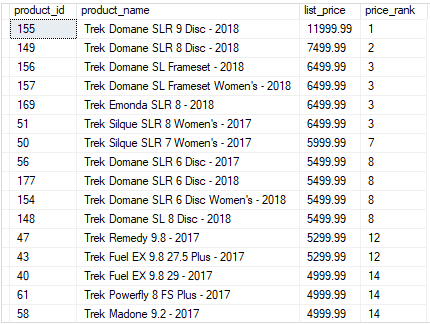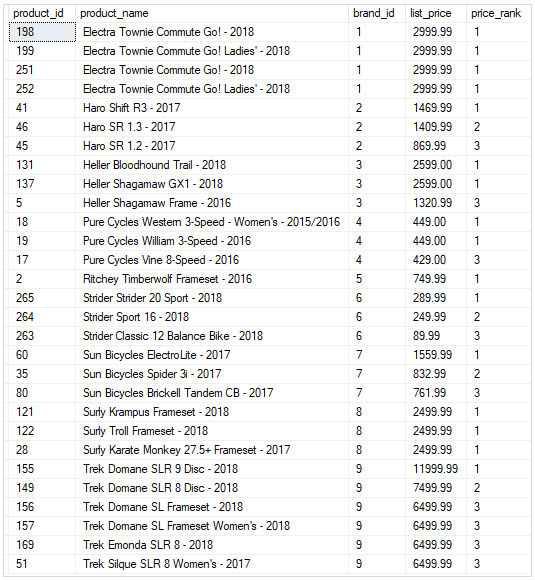Summary: in this tutorial, you will learn how to use SQL Server RANK() function to calculate a rank for each row within a partition of a result set.
Introduction to SQL Server RANK() function
The RANK() function is a window function that assigns a rank to each row within a partition of a result set.
The rows within a partition that have the same values will receive the same rank. The rank of the first row within a partition is one. The RANK() function adds the number of tied rows to the tied rank to calculate the rank of the next row, therefore, the ranks may not be consecutive.
The following shows the syntax of the RANK() function:
RANK() OVER (
[PARTITION BY partition_expression, ... ]
ORDER BY sort_expression [ASC | DESC], ...
)
Code language: SQL (Structured Query Language) (sql)In this syntax:
- First, the
PARTITION BYclause divides the rows of the result set partitions to which the function is applied. - Second, the
ORDER BYclause specifies the logical sort order of the rows in each a partition to which the function is applied.
The RANK() function is useful for top-N and bottom-N reports.
SQL Server RANK() illustration
First, create a new table named sales.rank_demo that has one column:
CREATE TABLE sales.rank_demo (
v VARCHAR(10)
);
Code language: SQL (Structured Query Language) (sql)Second, insert some rows into the sales.rank_demo table:
INSERT INTO sales.rank_demo(v)
VALUES('A'),('B'),('B'),('C'),('C'),('D'),('E');
Code language: SQL (Structured Query Language) (sql)Third, query data from the sales.rank_demo table:
SELECT v FROM sales.rank_demo;Code language: SQL (Structured Query Language) (sql)Fourth, use the ROW_NUMBER() to assign ranks to the rows in the result set of sales.rank_demo table:
SELECT
v,
RANK () OVER (
ORDER BY v
) rank_no
FROM
sales.rank_demo;
Code language: SQL (Structured Query Language) (sql)Here is the output:

As shown clearly from the output, the second and third rows receive the same rank because they have the same value B. The fourth and fifth rows get the rank 4 because the RANK() function skips the rank 3 and both of them also have the same values.
SQL Server RANK() function examples
We’ll use the production.products table to demonstrate the RANK() function:

Using SQL Server RANK() function over a result set example
The following example uses the RANK() function to assign ranks to the products by their list prices:
SELECT
product_id,
product_name,
list_price,
RANK () OVER (
ORDER BY list_price DESC
) price_rank
FROM
production.products;
Code language: SQL (Structured Query Language) (sql)Here is the result set:

In this example, because we skipped the PARTITION BY clause, the RANK() function treated the whole result set as a single partition.
The RANK() function assigns a rank to each row within the result set sorted by list price from high to low.
Using SQL Server RANK() function over partitions example
This example uses the RANK() function to assign a rank to each product by list price in each brand and returns products with rank less than or equal to three:
SELECT * FROM (
SELECT
product_id,
product_name,
brand_id,
list_price,
RANK () OVER (
PARTITION BY brand_id
ORDER BY list_price DESC
) price_rank
FROM
production.products
) t
WHERE price_rank <= 3;Code language: SQL (Structured Query Language) (sql)The following picture shows the output:

In this example:
- First, the
PARTITION BYclause divides the products into partitions by brand Id. - Second, the
ORDER BYclause sorts products in each partition by list prices. - Third, the outer query returns the products whose rank values are less than or equal to three.
The RANK() function is applied to each row in each partition and reinitialized when crossing the partition’s boundary.
In this tutorial, you have learned how to use the SQL Server RANK() function to assign a rank to each row within a partition of a result set.